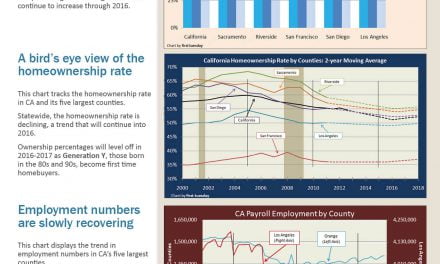The rise of maintenance services
In the wake of the recession and mortgage crisis, hundreds of thousands of Californians saw their credit scores drop – some substantially. Mostly, the downgrading was due to causes outside their control.
Today, more potential homebuyers have low credit ratings than ever before. They are casualties in the battle between a rock and a hard place: the deregulated loose lending standards of the boom wrecked their credit. Now, the return of fundamental loan underwriting guidelines keeps them from obtaining new mortgage financing..
In this economic climate, companies offering credit repair services are working their way towards the huge pool of credit-damaged homebuyers. These credit repair organizations advertise they can help raise credit scores and remove bad credit — for a fee.
Buyers unable to qualify for residential mortgage loans, except at higher risky rates due to poor credit scoring, are drawn to these offerings. They see an opportunity to lift their scores. But do these credit repair companies really have secret weapons to combat bad credit scores? And if these programs do improve credit, how do they work?
Revealing a magician’s tricks
Credit repair organizations often stoke fears that most credit reports are littered with errors. In truth, only a small percentage contain errors large enough to dramatically affect a consumer’s credit. According to a 2012 executive report by the Federal Trade Commission, one in five consumers has an error in their credit report. However, only 2.2% of consumers had errors dramatic enough to negatively affect their access to higher credit.
Related article
Fair Trade Commission report
Consumers may dispute the accuracy of any information within their credit report under the Fair Credit Reporting Act (FCRA). This protects consumers from inaccurate or fraudulent items that appear on their credit reports. [15 United States Code §1681i (a)(1)(A)]
To dispute credit information, the consumer first sends a request to the credit bureaus. the credit bureau has 30 days from the receipt of the request to verify the accuracy of the negative item. If they fail to act, which is common, the disputed item must be removed from the credit report. [15 USC §1681i(a)(1)(A)]
The credit repair business hinges on the consumer’s right to dispute items in a credit report. Here’s how it works: credit repair organizations request a consumer’s credit report on behalf of the consumer. They then comb through the report finding any negative items.
At this point, the credit repair organizations either assist the consumer in drafting a letter of dispute or simply have the consumer sign a stock letter regarding each negative item. Their modus operandi is to dispute as many items as possible, and count on at least a handful of items being removed from the consumer’s credit report for failure of the agency to respond within 30 days. Once the disputed items are removed, the consumer’s credit score goes up.
Thus, the credit repair organizations bet on the bureaus’ complaisance or inability to verify each dispute within the 30-day timeline.
However, items that the bureaus verify as accurate cannot be permanently removed. What credit repair organizations don’t typically disclose is that a credit bureau can (and will) reinstate a deleted derogatory item if it later verifies the existence and accuracy of that item.
Of course, the removal of an item from a credit report does not eliminate the underlying debt. An outstanding debt is not forgiven simply because it is removed from a consumer’s credit report. [15 USC § 1681i(a)(5)(B)(i)]
Related article
The lenders are watching
Thus, even when a credit repair organization is able to raise a consumer’s credit score by disputing accurate items on a credit report, it’s only temporary. The disputed items — and the negative impact they have on credit scores — may reappear in the future.
Section 609 disputes
The blanket dispute campaign is not the only method employed by credit repair organizations. Another “credit repair” tactic involves disputing outdated and unverifiable derogatory information. This is known as a Section 609 credit dispute. [15 USC §1681g(c)(2)(E)]
This is how a section 609 credit dispute works: a lender — let’s say a bank which originates a mortgage — reports the loan to the credit bureaus. This places a burden on the credit bureaus to verify the existence of the mortgage debt. The verification takes the form of a signed note. However, bureaus either don’t request this information before reporting the debt (imagine the sheer volume of paperwork), or they bury the paperwork they receive in warehouse archives.
With all the consumers in the nation, and all the debt, what are the odds a credit bureau is able to retrieve and present evidence of the debt? Or perhaps a better question is: what’s a credit bureau’s cost of storing literally billions of signed debt agreements vs. the cost of simply removing the debt from the consumer’s credit report?
Most of the time, the credit bureaus simply remove the item from the credit report. Voila: the credit score rises. If this consumer demand for verification doesn’t compel the credit bureaus to remove the disputed items, credit repair organizations then elevate the complaint to the California attorney general. In response, the attorney general compels the bureaus to either produce the paperwork, or remove the disputed item.
Using these methods, credit repair organizations may advertise they can remove short sales, foreclosure, judgments, even bankruptcies. Some organizations claim they can remove these blemishes for up to six months. Still others purport to have a proprietary means of keeping them off for longer. The cost? Around $100 a month.
What credit repair organizations do is coerce the credit bureaus to drop the “disputed” item from the consumer’s credit report. However, if a debt is legally collectible from the individual borrower – purchase-assist mortgages for your home are not – the debt remains even though no longer reflected on the credit report.
Additionally, when a homebuyer prepares a loan application and the lender inquires about debt or other past negative financial history, the applicant will be asked to disclose this information. It is deceptive to remain silent about such information even if it was “removed” from the credit report. Loan originators know the standard residential loan application (the Fannie Mae 1003 or the Freddie Mac 65) asks if the applicant has outstanding judgments against them (which or course do not occur with purchase assist mortgages that funded acquisition of the borrower’s home). [15 USC §1679b(a)]
Related article
May a lender obtain a deficiency judgment against an owner on a short sale?
Credit repair organization oversight
Consumers of credit repair services are protected against fraud or misrepresentation under the Credit Repair Organization Act (CROA) of 1996. The activities of credit repair services are controlled by the CROA.
Related article
The FICO farce
One common unlawful credit repair tactic practiced by some credit repair organizations is to instruct the consumer to apply for an Employee Identification Number (EIN). In this fashion, the consumer creates another identity for credit scoring. The consumer then uses the new EIN in place of their Social Security number to deflect lenders away from their negative personal credit history. This practice is known as file segregation. [15 USC §1679b(a)(2)]
Responsibilities owed the consumer
To educate consumers to conform to lender standards, a credit repair organization informs consumers about their financial rights by providing them with a CROA statement.
To further protect consumers, agreements between a credit repair organization and the consumer are written. Also, credit repair services cannot be provided before three business days have passed after entering into the written agreement for services. [15 USC § 1679d(a)]
Credit repair contracts contain:
- the terms and conditions for payment of the service fee, including the total amount of all payments;
- a detailed description of the services to be performed by the credit repair ; and
- the statement: “You may cancel this contract without penalty or obligation at any time before midnight of the third business day after the date on which you signed the contract….” [15 USC §1679d(b)]
Punishing violators
Any attempt to obtain a waiver of these rights and protections is a CROA violation. [15 USC §§1679f(a)-(b)]
Credit repair organizations that violate the CROA are liable to the consumer for their actual money losses, punitive damages, court costs and attorney fees. There are no limits on the punitive damages a court may award an individual. [15 USC §1679g(a)]
The Federal Trade Commission (FTC) enforces and regulates the CROA. [15 USC §1679h(b); 15 USC §1679h]
Credit repair self-help
Before your client jumps head-first into a contract with a credit repair organization, tell them they have options. Consumers have the right to a free credit report from each bureau once every 12 months under the FCRA. Credit history varies from bureau to bureau. As different lenders favor information from different bureaus, it is good practice for consumers to check all three bureaus each year.
The official site to obtain this report is annualcreditreport.com.
While bureaus are required to provide a free credit report, they may charge a consumer to see their current credit score. In fact, the bureaus market the credit score, and credit monitoring services, on the same page as the free credit report.
Related article
The FICO score delusion
Remember, the credit score is separate and not crucial to the annual credit report check. The credit score is a numerical representation of the consumer’s credit history.
Have your client focus on reviewing the items on the report, rather than fixating on a number. The more familiar consumers are with the content and items listed in their own credit reports, the more they will engage in informed use of credit, like applying for a mortgage to fund the purchase of a home.
If consumers see an item in their report they believe is inaccurate, advise them of their right to dispute portions of their credit report without being subjected to a charge. Also advise consumers to retain copies of all correspondence and documents they send to the credit bureau or any credit repair service they might use. [15 USC §1681i(a)(1)(A)]
However, keep in mind that over 200 million individual files are kept at each credit bureau. At times, the volume of information overwhelms the bureaus’ ability to verify discrepancies. If your client is having trouble getting resolution, have them submit a complaint to the Consumer Financial Protection Bureau (CFPB). While consumers need to register disputes with the bureaus first, the CFPB provides consumers with a fallback option – when the bureaus do not respond in a timely manner.















I did not see anything on how long it may take to raise a score after several late payments. No foreclosure, or short sale or BK just lates in trying to get the banks attention.
PVD